Species and Ecosystems Emergencies
Arctic
Climate change has dire implications for polar ecosystems, which are losing much of the ice that defines their existence. The Arctic Biodiversity Assessment (ABA) was compiled by the Arctic Council. The ABA serves to provide baseline information against which further changes can be compared, and also to identify gaps in scientific knowledge of the Arctic. The Assessment could be a valuable resource for further conservation work in the Arctic. Key findings include the fact that the Arctic is being degraded but that decisive action can still make a difference and that climate change is the most serious threat to Arctic biodiversity and also intensifies all the other threats. The Arctic Council maintains a website that includes the full text of the Assessment and also fully explains the implications of the report for Arctic conservation.
Climate change has dire implications for polar ecosystems, which are losing much of the ice that defines their existence. The Arctic Biodiversity Assessment (ABA) was compiled by the Arctic Council. The ABA serves to provide baseline information against which further changes can be compared, and also to identify gaps in scientific knowledge of the Arctic. The Assessment could be a valuable resource for further conservation work in the Arctic. Key findings include the fact that the Arctic is being degraded but that decisive action can still make a difference and that climate change is the most serious threat to Arctic biodiversity and also intensifies all the other threats. The Arctic Council maintains a website that includes the full text of the Assessment and also fully explains the implications of the report for Arctic conservation.
Amphibians and fish
ocean life
A study by M.J. Adams, D.A.W. Miller, and others on the rate of decline among amphibian populations has alarming results.Quoting from the paper's Abstract:
"Though a third of amphibian species worldwide are thought to be imperiled, existing assessments simply categorize extinction risk.... We found that overall occupancy by amphibians declined 3.7% annually from 2002 to 2011. Species that are Red-listed by the International Union for Conservation of Nature (IUCN) declined an average of 11.6% annually.... This analysis suggests that amphibian declines may be more widespread and severe than previously realized."
There are many reasons for this decline, including habitat destruction and the widespread fungal disease, chytridiomycosis. Climate change is thought to play a significant role as well.
The full text of the paper is available, for free, online.
ocean life
A study by M.J. Adams, D.A.W. Miller, and others on the rate of decline among amphibian populations has alarming results.Quoting from the paper's Abstract:
"Though a third of amphibian species worldwide are thought to be imperiled, existing assessments simply categorize extinction risk.... We found that overall occupancy by amphibians declined 3.7% annually from 2002 to 2011. Species that are Red-listed by the International Union for Conservation of Nature (IUCN) declined an average of 11.6% annually.... This analysis suggests that amphibian declines may be more widespread and severe than previously realized."
There are many reasons for this decline, including habitat destruction and the widespread fungal disease, chytridiomycosis. Climate change is thought to play a significant role as well.
The full text of the paper is available, for free, online.
o An Associated Press article, published June 2013 , calls attention to dramatic losses in the Atlantic puffin population, possibly because of changes in the distribution of fish. Among other problems, many puffins have shifted from feeding their young mostly herring, a species that is becoming less available, in favor of feeding them butterfish, a southerly species that is moving north. Unfortunately, butterfish are too big for puffin chicks to eat, and many have starved to death. Puffins have been a dramatic conservation success story, since they had been badly over-hunted in the eighteen hundreds and have since recovered. They are now at risk again.
o Australian
news reports that a fish and dolphin kill in March and April 2013 has been
traced to a combination of abnormally warm water, an algae bloom, and a virus.
Members of a government task force investigating the matter say that warmer
ocean temperatures stressed the animals to the point where ordinarily
survivable problems became
lethal.
o A 2013 study shows that purple martins cannot adjust the timing of their spring migration in response to earlier and earlier spring warming. Since these birds' food sources do adjust themselves to the changing climate, purple martins may now be arriving on their breeding territories too late in the year to adequately feed their young. This could be one of the reasons purple martin populations are now declining. Similar problems have been suspected for many other bird species, and confirmed for some.
A key paper for the IPCC ecological assessment AR4 and AR5 (supported) is
by C. Thomas Extinction Risks from Climate Change.
As we are fixed on the worst case emissions scenario and habitat loss
continues unabated the actual projected extinction rate based from the
Thomas paper is much worse than has been reported.
It is 33% with dispersal benefit of species and 58% with no dispersal.
Because the rate of climate change is unprecedented for the vast
majority f species the 58% must be assumed most likely.
Assessing for risk the 58% would be the figure used.
We are on a fixed heading for a global warming of 6C by 2100 (International Energy Agency) and a possible 4C warming by 2060 (R. Betts 2011) . A World Bank reports shows we are also committing ourselves to a 4C warming. The IPCC 2007 assessment found that As global average temperature increase exceeds about 3.5°C (i.e. 4C from pre-industrial), model projections suggest significant extinctions (40 to 70% of species assessed) around the globe.
Obviously we can expect polar, mountaintop and desert ecosystems and biodiversity to suffer large losses with even small degrees of warming. The Amazon is the greatest home of natural bio diversity and it may be particularly vulnerable to global warming, because it makes its own self sustaining weather.
Forests
Deforestation is both a cause and a result of global climate change.
The 2014 IPCC AR5 reports Extensive tree mortality and widespread forest dieback (high mortality rates at a regional scale) linked to drought and temperature stress have been documented recently on all vegetated continents. Long-term increasing tree mortality rates associated with temperature increases and drought have been documented in boreal and temperate forests in western North America. Episodes of widespread die-back have been observed in multiple vegetation types, particularly in western North America, Australia, and southern Europe (AR5 WG2 Box 4.2, Fig 4.7)
Deforestation contributes 6–17% CO2 emissions (A. Baccini et al Nature 2012)
"Trees: our life savers are dying" (US) July 2013 The Guardian Jim Robbins
Oct 2013 Climate change affecting North American forests, researchers find.
FAO 2011 literature review Forests and Climate Change
As far back as 2000 Peter Cox published a model result (Acceleration of global warming due to carbon-cycle feedbacks in a coupled climate model) finding a high terrestrial carbon feedback warming of an added 1.5C by 2100 mostly due to a predicted Amazon die-back. The die-back results from increased Amazon drought and drying.
We find that under a 'business as usual' scenario, the terrestrial biosphere acts as an overall carbon sink until about 2050, but turns into a source thereafter. By 2100, ... atmospheric CO2 concentrations are 250 p.p.m.v. higher in our fully coupled simulation than in uncoupled carbon models, resulting in a global-mean warming of 5.5 K, as compared to 4 K without the carbon-cycle feedback.
Other models have been published without Amazon die back and lower terrestrial carbon feedback warming (0.5C). Field research since 2000 tends to confirm the risk of catastrophic die back under warming real. The carbon cycle modeling on the other hand suggests that high CO2 fertilization will protect the Amazon from global warming heat and drying, but if the assumed CO2 fertilization does not happen die back will.
by C. Thomas Extinction Risks from Climate Change.
As we are fixed on the worst case emissions scenario and habitat loss
continues unabated the actual projected extinction rate based from the
Thomas paper is much worse than has been reported.
It is 33% with dispersal benefit of species and 58% with no dispersal.
Because the rate of climate change is unprecedented for the vast
majority f species the 58% must be assumed most likely.
Assessing for risk the 58% would be the figure used.
We are on a fixed heading for a global warming of 6C by 2100 (International Energy Agency) and a possible 4C warming by 2060 (R. Betts 2011) . A World Bank reports shows we are also committing ourselves to a 4C warming. The IPCC 2007 assessment found that As global average temperature increase exceeds about 3.5°C (i.e. 4C from pre-industrial), model projections suggest significant extinctions (40 to 70% of species assessed) around the globe.
Obviously we can expect polar, mountaintop and desert ecosystems and biodiversity to suffer large losses with even small degrees of warming. The Amazon is the greatest home of natural bio diversity and it may be particularly vulnerable to global warming, because it makes its own self sustaining weather.
Forests
Deforestation is both a cause and a result of global climate change.
The 2014 IPCC AR5 reports Extensive tree mortality and widespread forest dieback (high mortality rates at a regional scale) linked to drought and temperature stress have been documented recently on all vegetated continents. Long-term increasing tree mortality rates associated with temperature increases and drought have been documented in boreal and temperate forests in western North America. Episodes of widespread die-back have been observed in multiple vegetation types, particularly in western North America, Australia, and southern Europe (AR5 WG2 Box 4.2, Fig 4.7)
Deforestation contributes 6–17% CO2 emissions (A. Baccini et al Nature 2012)
"Trees: our life savers are dying" (US) July 2013 The Guardian Jim Robbins
Oct 2013 Climate change affecting North American forests, researchers find.
FAO 2011 literature review Forests and Climate Change
As far back as 2000 Peter Cox published a model result (Acceleration of global warming due to carbon-cycle feedbacks in a coupled climate model) finding a high terrestrial carbon feedback warming of an added 1.5C by 2100 mostly due to a predicted Amazon die-back. The die-back results from increased Amazon drought and drying.
We find that under a 'business as usual' scenario, the terrestrial biosphere acts as an overall carbon sink until about 2050, but turns into a source thereafter. By 2100, ... atmospheric CO2 concentrations are 250 p.p.m.v. higher in our fully coupled simulation than in uncoupled carbon models, resulting in a global-mean warming of 5.5 K, as compared to 4 K without the carbon-cycle feedback.
Other models have been published without Amazon die back and lower terrestrial carbon feedback warming (0.5C). Field research since 2000 tends to confirm the risk of catastrophic die back under warming real. The carbon cycle modeling on the other hand suggests that high CO2 fertilization will protect the Amazon from global warming heat and drying, but if the assumed CO2 fertilization does not happen die back will.
Birds
A study has identified which species of three well-studied groups (birds, amphibians, and corals) are at risk of extinction from climate change. Many of the species identified as at-risk are not otherwise considered threatened, suggesting that conservation priorities need to be expanded. However, the less the planet warms, the fewer species will be put at risk, suggesting that while some further warming is now inevitable, it is not too late to avert the worst catastrophes.
A study has identified which species of three well-studied groups (birds, amphibians, and corals) are at risk of extinction from climate change. Many of the species identified as at-risk are not otherwise considered threatened, suggesting that conservation priorities need to be expanded. However, the less the planet warms, the fewer species will be put at risk, suggesting that while some further warming is now inevitable, it is not too late to avert the worst catastrophes.
o The National Wildlife Federation released a report June 2013 stating that even many common bird species are under threat from climate change. Migratory birds especially are vulnerable because so many of them are extreme specialists dependent on several different habitats in sequence. For example, many birds time their migrations so as to be able to take advantage of food resources at very specific places at very specific times. As climate change shifts the seasons, the timing of availability for some of these resources is also shifting, and a shift by as little as a few days could mean that the birds arrive too early or too late to eat. A given bird species might need two, three, or more different habitats every year, and if the timing of just one of these fails, the bird cannot breed. The report calls for the United States to take a leadership role in controlling climate change by taking immediate action to reduce its greenhouse gas emissions.
IUCN 2013 press release, the IUCN has updated its Red List of species by conservation status. This update reports about a third of assessed speciescurrently considered threatened or endangered. Among the most dramatic changes is that a full third of all known conifer species are now considered threatened or endangered.
Natural Resources Canada published the first review of global tree mortality due to climate causes. Their report shows that increased tree dieback may occur in many areas and is already occurring in some areas.
Many other forested regions will be damaged or lost by global climate change. A recent study shows that some forested areas that are becoming drier due to global climate change are no longer able to regenerate following forest fires. Instead, these areas grow back with other, non-forest communities. Trees, like many other organisms, are much more vulnerable when young, so that adult trees can persist in conditions too harsh for seedlings to live. This means that some sites that are currently forested will also be permanently deforested if struck by a major forest fire. Since increased fire frequency is also a likely consequence for climate change, sooner or later these areas will burn.
The image (right) , from the Intergovernmental Panel on Climate Change 2007 assessment , shows what different degrees of warming would mean for life on earth and what, exactly, will be lost if further climate change is not averted. Please note the IPCC note. These impacts are from climate change alone. In the real world they impact on top of the 6th mass extinction event due mainly to human habitat alterations.
As our image shows (click to enlarge) without an all out drastic emergency response we are committed to a warming of over 3C by 2100.
A huge number of species will not be able to adapt to the rapid rate of climate change on top of direct habitat loss and degradation. Endangered wildlife species whose numbers are already declining, such as amphibians, migratory species, and species with the longest reproductive cycles, are most at risk.
As our image shows (click to enlarge) without an all out drastic emergency response we are committed to a warming of over 3C by 2100.
A huge number of species will not be able to adapt to the rapid rate of climate change on top of direct habitat loss and degradation. Endangered wildlife species whose numbers are already declining, such as amphibians, migratory species, and species with the longest reproductive cycles, are most at risk.

Two Severe Amazon Droughts in Five Years (2005, 2010) 2011 study alarms Scientists. The 2010 Amazon Drought. S.L. Lewis Science, 2011
A special 2011 UNEP report Drought, Fire and Deforestation in the Amazon:
Feedbacks, Uncertainty and the Precautionary Approach, covered the issue.
In particular is this 2013 released NASA study Severe Climate Jeopardizing Amazon Forest. The published paper source is here. Nature 2012 Severe drought has lasting effects on Amazon Satellite data reveal effects of climate change on tropical forests. An area of the Amazon rainforest twice the size of California continues to suffer from the effects of a megadrought that began in 2005, finds a new NASA-led study. These results, together with observed recurrences of droughts every few years and associated damage to the forests in southern and western Amazonia in the past decade, suggest these rainforests may be showing the first signs of potential large-scale degradation due to climate change. The record shows Amazon is experiencing a drought rate that is unprecedented in a century.
A special 2011 UNEP report Drought, Fire and Deforestation in the Amazon:
Feedbacks, Uncertainty and the Precautionary Approach, covered the issue.
In particular is this 2013 released NASA study Severe Climate Jeopardizing Amazon Forest. The published paper source is here. Nature 2012 Severe drought has lasting effects on Amazon Satellite data reveal effects of climate change on tropical forests. An area of the Amazon rainforest twice the size of California continues to suffer from the effects of a megadrought that began in 2005, finds a new NASA-led study. These results, together with observed recurrences of droughts every few years and associated damage to the forests in southern and western Amazonia in the past decade, suggest these rainforests may be showing the first signs of potential large-scale degradation due to climate change. The record shows Amazon is experiencing a drought rate that is unprecedented in a century.
It has been discovered that billions of trees died after the 2010 Amazon drought.
Simon Lewis one of the study authors, a forest ecologist at the University of Leeds in Great Britain, commented - 'those two unusual events are consistent with those predictions that suggest that the Amazon may be severely impacted over the next few decades by these droughts,"
Another NASA observation reported 2013 finds Hidden Wildfires Taking Big Toll on Amazon Rainforest . These understorey below canopy in several years have affected several times more rainforest than intentional clearing.
A 2004 Royal Society paper Contrasting simulated past and future responses of the Amazonian forest to atmospheric change concluded We speculate that the Amazonian forest is currently near its critical resiliency threshold, and that "even minor climate warming may be sufficient to promote deleterious feedbacks on forest integrity."
Simon Lewis one of the study authors, a forest ecologist at the University of Leeds in Great Britain, commented - 'those two unusual events are consistent with those predictions that suggest that the Amazon may be severely impacted over the next few decades by these droughts,"
Another NASA observation reported 2013 finds Hidden Wildfires Taking Big Toll on Amazon Rainforest . These understorey below canopy in several years have affected several times more rainforest than intentional clearing.
A 2004 Royal Society paper Contrasting simulated past and future responses of the Amazonian forest to atmospheric change concluded We speculate that the Amazonian forest is currently near its critical resiliency threshold, and that "even minor climate warming may be sufficient to promote deleterious feedbacks on forest integrity."
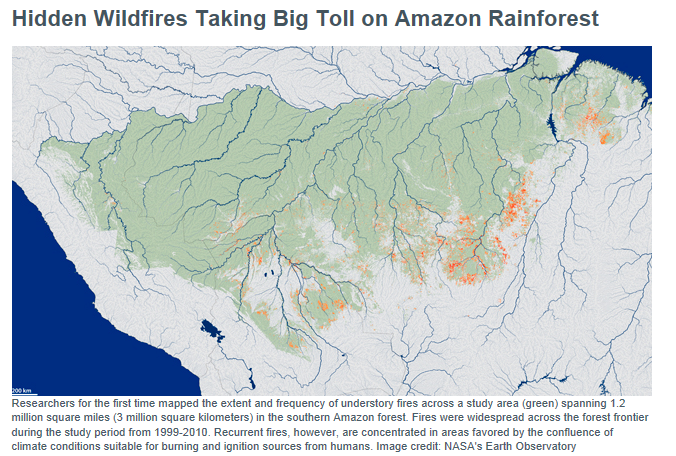
o An article, published in July by the University of Arizona News, draws attention to the dangerous speed of climate change. According to the study the article describes, vertebrates do not typically evolve rapidly enough to adjust to the current and projected rate of change. This means many species will go extinct, if they cannot alter their ranges quickly enough. And of course, many cannot alter their ranges.
2015 research shows the Amazon and Boreal Forests face climate change tipping points.
IPCC 2014 AR5 WG2 Forests will be unable migrate to avoid climate change impacts and regional forest ecosystem transformation
9 July 2013 — Global Climate Change Extinction. To survive global climate change this century, most vertebrate species would have to evolve about 10,000 times faster than they have in the past to adapt to the extreme speed of projected climate change University of Arizona research
IPCC 2014 AR5 WG2 Forests will be unable migrate to avoid climate change impacts and regional forest ecosystem transformation
9 July 2013 — Global Climate Change Extinction. To survive global climate change this century, most vertebrate species would have to evolve about 10,000 times faster than they have in the past to adapt to the extreme speed of projected climate change University of Arizona research
2 Aug 2013 Science Stanford review reports that ecosystem climate changes will intensify in the coming decades,
unfolding at a rate that is potentially
several orders of magnitude—more rapid
than the changes to which terrestrial ecosystems
have been exposed during the
past 65 million years. The combination
of high climate-change velocity and multidimensional
human fragmentation will
present terrestrial ecosystems with an
environment that is unprecedented in recent
evolutionary history.
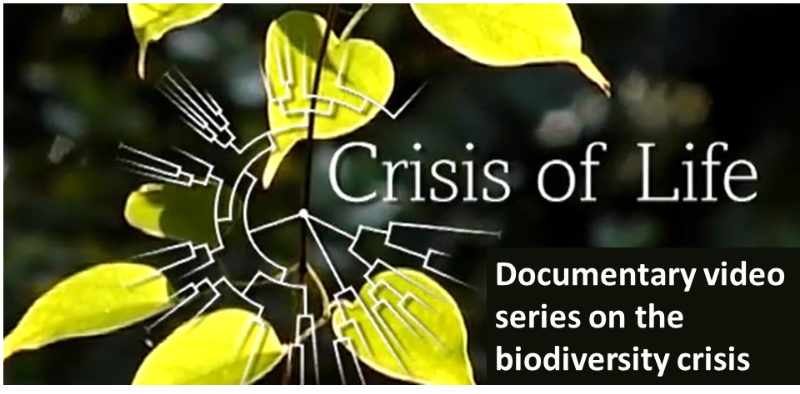
Ecosystem danger limit 1.0-1.5C (global average from pre-industrial)
"Earlier IPCC reports described several ecosystems to be resilient to warming up to 1°C. During the course of this century the resilience of many ecosystems (their ability to adapt naturally) is likely to be exceeded by an unprecedented combination of change in climate, associated disturbances (e.g., flooding, drought, wildfire, insects, ocean acidification) and in other global change drivers (especially land-use change, pollution and over-exploitation of resources), if greenhouse gas emissions and other changes continue at or above current rates (high confidence).
Many significant impacts of climate change may emerge through shifts in the intensity and the frequency of extreme weather events. Extreme events can cause mass mortality of individuals and contribute significantly to determining which species occur in ecosystems
Despite the recognized importance of multiple drivers of ecosystem change, they are rarely all included in current climate and ecosystem models used for assessing climate change impacts on ecosystems. The explicit inclusion of non-climatic drivers and their associated interactions in analyses of future climate change impacts could lead to unexpected outcomes. Consequently, many impact studies of climate change that ignore land-use and other global change trends may represent inadequate estimates of projected ecosystem responses."
IPCC AR4 2007
"Earlier IPCC reports described several ecosystems to be resilient to warming up to 1°C. During the course of this century the resilience of many ecosystems (their ability to adapt naturally) is likely to be exceeded by an unprecedented combination of change in climate, associated disturbances (e.g., flooding, drought, wildfire, insects, ocean acidification) and in other global change drivers (especially land-use change, pollution and over-exploitation of resources), if greenhouse gas emissions and other changes continue at or above current rates (high confidence).
Many significant impacts of climate change may emerge through shifts in the intensity and the frequency of extreme weather events. Extreme events can cause mass mortality of individuals and contribute significantly to determining which species occur in ecosystems
Despite the recognized importance of multiple drivers of ecosystem change, they are rarely all included in current climate and ecosystem models used for assessing climate change impacts on ecosystems. The explicit inclusion of non-climatic drivers and their associated interactions in analyses of future climate change impacts could lead to unexpected outcomes. Consequently, many impact studies of climate change that ignore land-use and other global change trends may represent inadequate estimates of projected ecosystem responses."
IPCC AR4 2007
Plants
o While climate change is obviously altering what regions have the right conditions to support which plants. However, especially with very long-lived plants, such as trees, actual changes in plant community structure could take a long time to show up. Plants take time to move into new areas, and they can also persist in places where the climate no longer suits them, because adult plants can live under conditions that would kill their seedlings. These delays can last thousands of years.
A recent study explored the ways these delays can complicate both forest management and conservation in this time of rapid change.
The long life cycle of trees may nor allow them to not migrate in response to raid warming.
American research 2013 from Duke University finds the life cycle is being reduced bu the trees are no shifting.
Research from Israel in 2011 finds that Trees which disperse their seeds by wind, such as pines and maples, will be unable to spread at a pace that can cope with expected climate changes.
o While climate change is obviously altering what regions have the right conditions to support which plants. However, especially with very long-lived plants, such as trees, actual changes in plant community structure could take a long time to show up. Plants take time to move into new areas, and they can also persist in places where the climate no longer suits them, because adult plants can live under conditions that would kill their seedlings. These delays can last thousands of years.
A recent study explored the ways these delays can complicate both forest management and conservation in this time of rapid change.
The long life cycle of trees may nor allow them to not migrate in response to raid warming.
American research 2013 from Duke University finds the life cycle is being reduced bu the trees are no shifting.
Research from Israel in 2011 finds that Trees which disperse their seeds by wind, such as pines and maples, will be unable to spread at a pace that can cope with expected climate changes.
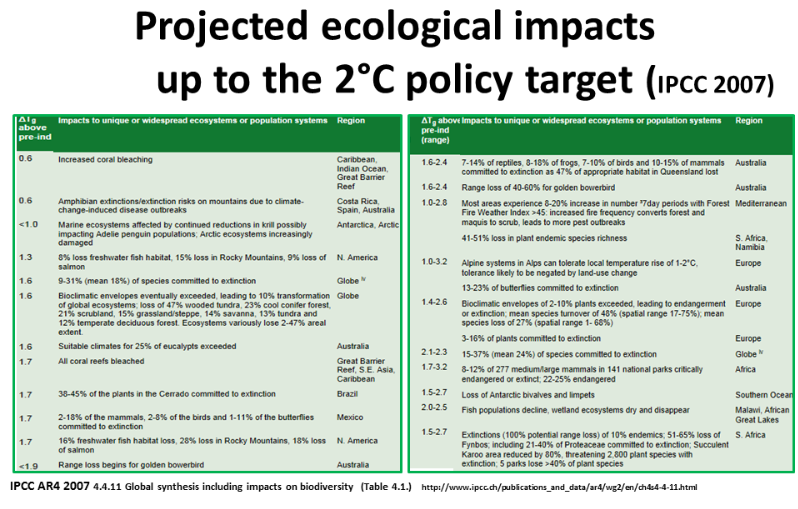
The prevention of damage to global ecosystems beyond their resilience is a provision in the 1992 UN climate convention.
That limit was assessed at 1.0C back in 1990 because 'Temperature Increases beyond 1C may elicit rapid unpredictable and non linear responses that could lead to extensive ecosystem damage. (Rijsberman, F. R. & Swart, R. J. Targets and Indicators of Climatic Change Stockholm Environment Institute, 1990).
The 2C policy target is global ecological catastrophe from the IPCC AR4 data. The long term target is now 1.5C.
That limit was assessed at 1.0C back in 1990 because 'Temperature Increases beyond 1C may elicit rapid unpredictable and non linear responses that could lead to extensive ecosystem damage. (Rijsberman, F. R. & Swart, R. J. Targets and Indicators of Climatic Change Stockholm Environment Institute, 1990).
The 2C policy target is global ecological catastrophe from the IPCC AR4 data. The long term target is now 1.5C.
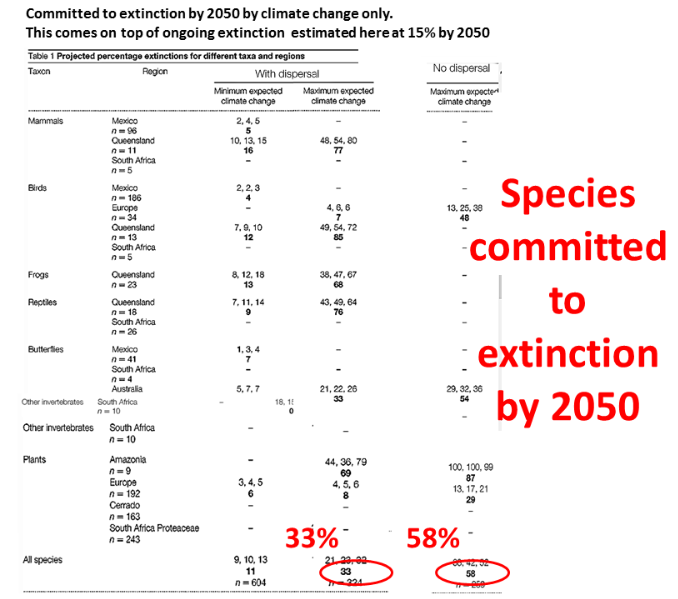
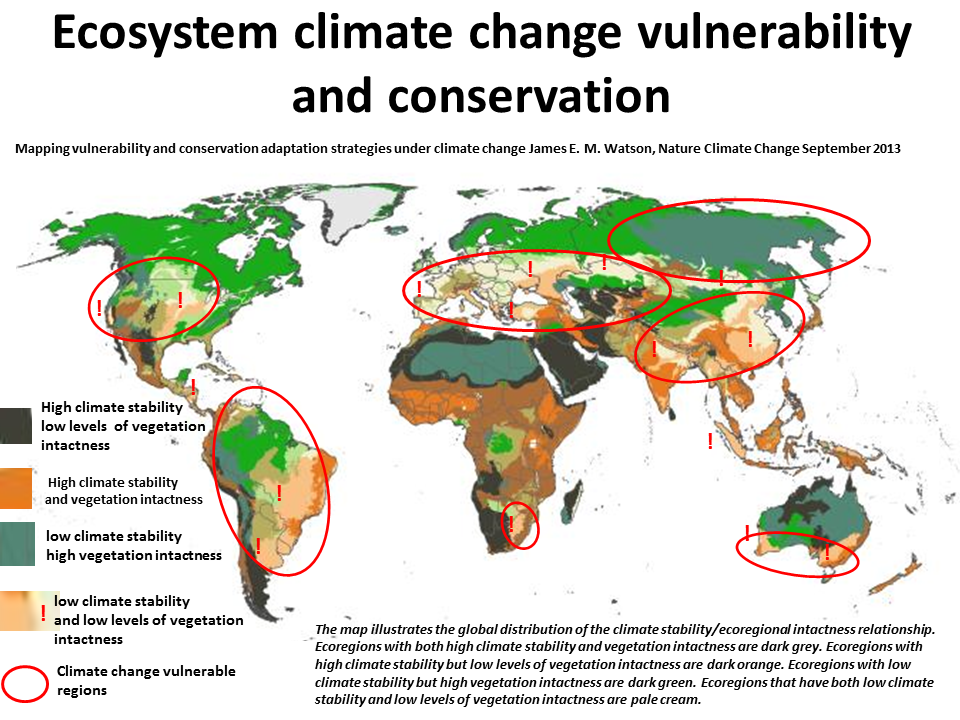
The map is from Mapping vulnerability and conservation adaptation strategies under climate change
James E. M. Watson, Sept 2013 Nature Climate Change ' The relationship between intactness (adaptive capacity) and stability (exposure) varies widely across ecoregions, with some of the most vulnerable, according to this measure, located in southern and southeastern Asia, western and central Europe, eastern South America and southern Australia.
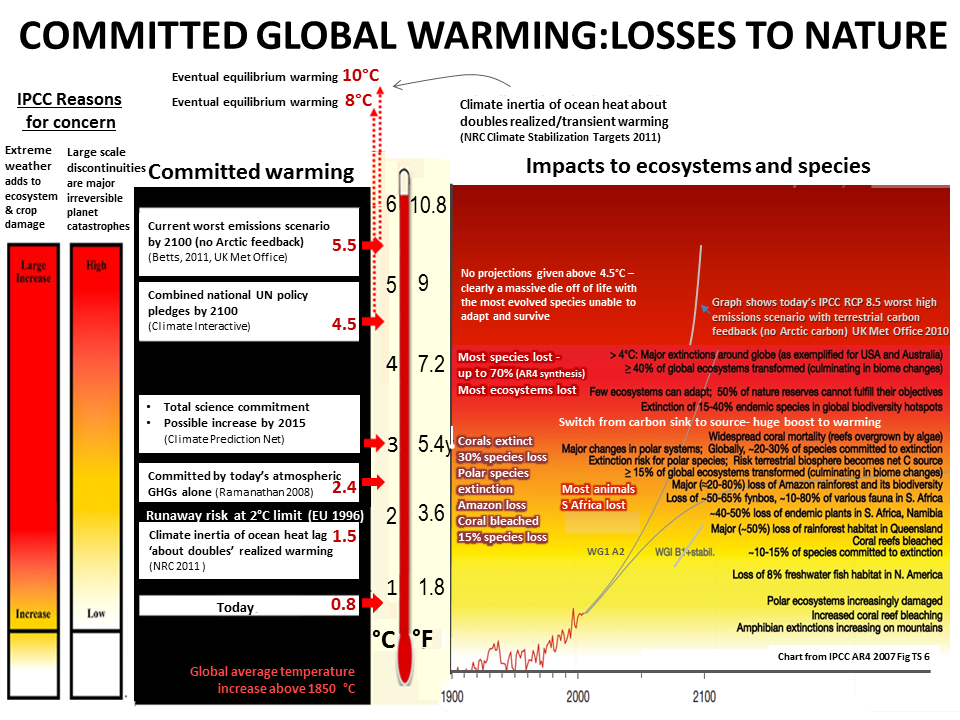
Oct 2013 Global Warming Forecast for Amazon Rain Forest: Dry and Dying
PNAS Oct 2013
PNAS Oct 2013
Amazon tipping interactions 2007 Interactions among Amazon prospects for a near-term forest tipping point D. Nepstad
,
,
Global warming in Amazonia: Impacts & itigation 2009 P. Fearnside
2009 Amazon could shrink by 85% due to climate change, scientists say.
2009 Amazon could shrink by 85% due to climate change, scientists say.
10 Nov 2016 Climate change already dramatically disrupting all elements of nature. The paper The broad footprint of climate change from genes to biomes to people
16 Sept 2016 Ecological selectivity of the emerging mass extinction in the oceans
June 2016 Fighting deforestation alone fails tropical biodiversity
22 May 2016 End-Cretaceous extinction in Antarctica linked to both Deccan volcanism and meteorite impact via climate change (global warming X2)
Feb 17 2016 Most climate change sensitive regions
20 Nov 2015 global conservation status Amazonian tree species @ half Amazon tree species threatened
extra 20% to general species Most of worlds tropical tree species threatened
Oct 2015 Article The Rapid Decline of World's Vast Boreal Forests
21 Sept 2015
Forest loss and land degradation fuel climate crisis
21 Sept 2015 Net forest loss High-Resolution Global Maps of
21st-Century Forest Cover Change
3 Sept 2015 Climate Change Is Already Reshaping The Earth- extending dry zones
2 Sept 2015 Earth has 3 trillion trees but they're falling at alarming rate
31 Aug 2015
Boreal: Northern forests face onslaught from heat and drought-a well as other world forests.
August 2015 Boreal Forest (30% world's forest) faces climate tipping point
2015 Plos special collection Ecological Imapacts Climate Chnage
9 July 2015 Climate change killing off bumblebees at alarming rate: study
June 2015 Accelerated modern human–induced species losses
10 June 2015 Plants may run out of time to grow under ongoing climate change. Article Climate change will make the Amazon rainforest less rainy
June 2015 Accelerated modern human–induced species losses: Entering the sixth mass extinction
Gerardo Ceballos
1 June 2015 Nature Projected strengthening of Amazonian dry season
May 2015 Accelerating extinction risk from climate change
April 2015 Acidic oceans linked to greatest extinction ever
Rocks 252 million yrs --carbon dioxide from volcanoes made sea water lethal. 2 volcanic CO2 hits
Nature March 2015 Long-term decline of the Amazon carbon sink
R. J. W. Brienen,
Sc Daily March 2015 Amazon's carbon uptake declines as trees die faster. From a peak of two billion tonnes of carbon dioxide each year in the 1990s, the net uptake by the forest has halved
March 2015 Drought Weakens the Amazon’s Ability to Capture Carbon
Jan 2015 T. Webb Global Patterns of Extinction Risk in Marine and Non-marine Systems 20-25% well known species threat extinction same as land plants & animals.
Jan 2015 Marine defaunation: Animal loss in the global ocean
Douglas J. McCauley
Aug 2014 Alejandro Ordonez Combined speeds of climate and land-use change Double threat of climate change & land use change enhances risks to biodiversity
26 July 2014 Defaunation in Anthropocene
Nov 2014 Potential Disruption of Pollination..
June 2014 FAO Half of world's forest species at risk
S. Pimm May 2014 Extinction rate 1000X natural
May 2014 Climate change study reveals unappreciated impacts on biodiversity
April 2014 Switch from cattle fields to 'carbon farms' could tackle climate change, save endangered animals cheaply
April 2014 Widespread decline of Congo rainforest greenness in the past decade short video of browning
April 2014 Wildlife response to climate change underestimated (bird research).
April 2014 PNAS P. Brando Abrupt increases in Amazonian tree mortality due to drought–fire interactions
Feb 2014 Many species of fish living near the Equator will not thrive .
Feb 2014 Amazon projected to become net carbon source. Nature Drought sensitivity of Amazonian carbon balance ..
Feb 2014 Carbon implicated in rapid end Permian mass extinction
Feb 2014 High extinction rates by 2100Climate change causes high predictable, extinction risks
Feb 2014 Amazonian drought conditions add carbon dioxide to the atmosphere.
Jan 2014 Tropical ecosystem climate sensitivity increasing as capacity to store carbon declines, due tp drying and drought.
Nov 2013 High-Res. Global Maps of 21st-Century Forest Cover Change Earth satellites map global forest loss (2.3 million sq. km) and gain (0.8 million sq. km.) from 2000 to 2012.
2013 S. Ostberg Critical impacts of global warming on land ecosystems
Jun 2013 Most species
at greatest risk from climate change not conservation priorities
16 Sept 2016 Ecological selectivity of the emerging mass extinction in the oceans
June 2016 Fighting deforestation alone fails tropical biodiversity
22 May 2016 End-Cretaceous extinction in Antarctica linked to both Deccan volcanism and meteorite impact via climate change (global warming X2)
Feb 17 2016 Most climate change sensitive regions
20 Nov 2015 global conservation status Amazonian tree species @ half Amazon tree species threatened
extra 20% to general species Most of worlds tropical tree species threatened
Oct 2015 Article The Rapid Decline of World's Vast Boreal Forests
21 Sept 2015
Forest loss and land degradation fuel climate crisis
21 Sept 2015 Net forest loss High-Resolution Global Maps of
21st-Century Forest Cover Change
3 Sept 2015 Climate Change Is Already Reshaping The Earth- extending dry zones
2 Sept 2015 Earth has 3 trillion trees but they're falling at alarming rate
31 Aug 2015
Boreal: Northern forests face onslaught from heat and drought-a well as other world forests.
August 2015 Boreal Forest (30% world's forest) faces climate tipping point
2015 Plos special collection Ecological Imapacts Climate Chnage
9 July 2015 Climate change killing off bumblebees at alarming rate: study
June 2015 Accelerated modern human–induced species losses
10 June 2015 Plants may run out of time to grow under ongoing climate change. Article Climate change will make the Amazon rainforest less rainy
June 2015 Accelerated modern human–induced species losses: Entering the sixth mass extinction
Gerardo Ceballos
1 June 2015 Nature Projected strengthening of Amazonian dry season
May 2015 Accelerating extinction risk from climate change
April 2015 Acidic oceans linked to greatest extinction ever
Rocks 252 million yrs --carbon dioxide from volcanoes made sea water lethal. 2 volcanic CO2 hits
Nature March 2015 Long-term decline of the Amazon carbon sink
R. J. W. Brienen,
Sc Daily March 2015 Amazon's carbon uptake declines as trees die faster. From a peak of two billion tonnes of carbon dioxide each year in the 1990s, the net uptake by the forest has halved
March 2015 Drought Weakens the Amazon’s Ability to Capture Carbon
Jan 2015 T. Webb Global Patterns of Extinction Risk in Marine and Non-marine Systems 20-25% well known species threat extinction same as land plants & animals.
Jan 2015 Marine defaunation: Animal loss in the global ocean
Douglas J. McCauley
Aug 2014 Alejandro Ordonez Combined speeds of climate and land-use change Double threat of climate change & land use change enhances risks to biodiversity
26 July 2014 Defaunation in Anthropocene
Nov 2014 Potential Disruption of Pollination..
June 2014 FAO Half of world's forest species at risk
S. Pimm May 2014 Extinction rate 1000X natural
May 2014 Climate change study reveals unappreciated impacts on biodiversity
April 2014 Switch from cattle fields to 'carbon farms' could tackle climate change, save endangered animals cheaply
April 2014 Widespread decline of Congo rainforest greenness in the past decade short video of browning
April 2014 Wildlife response to climate change underestimated (bird research).
April 2014 PNAS P. Brando Abrupt increases in Amazonian tree mortality due to drought–fire interactions
Feb 2014 Many species of fish living near the Equator will not thrive .
Feb 2014 Amazon projected to become net carbon source. Nature Drought sensitivity of Amazonian carbon balance ..
Feb 2014 Carbon implicated in rapid end Permian mass extinction
Feb 2014 High extinction rates by 2100Climate change causes high predictable, extinction risks
Feb 2014 Amazonian drought conditions add carbon dioxide to the atmosphere.
Jan 2014 Tropical ecosystem climate sensitivity increasing as capacity to store carbon declines, due tp drying and drought.
Nov 2013 High-Res. Global Maps of 21st-Century Forest Cover Change Earth satellites map global forest loss (2.3 million sq. km) and gain (0.8 million sq. km.) from 2000 to 2012.
2013 S. Ostberg Critical impacts of global warming on land ecosystems
Jun 2013 Most species
at greatest risk from climate change not conservation priorities
The 2005 Exeter Dangerous Climate Change conference confirmed the long held opinion that 1 to 1.5C at a warming rate limit of 0.5C per century is the danger limit for species and ecosystems.
The conference published a comprehensive table of the ecology and rising degrees of warming.
The conference published a comprehensive table of the ecology and rising degrees of warming.
Projected
future climate change and other human-induced pressures are virtually certain to
be unprecedented compared with the past several hundred
millennia (IPCC AR4 WG2 Ch4 1.2 Key Issues)
2011 Science The 2010 Amazon Drought S. Lewis Amazon switching from net carbon sink to source
Feb 2014 VIDEO The Sixth Extinction: Elizabeth Kolbert How Humans Are Causing Largest Die-Off since Dinosaurs


CLIMATE EMERGENCY INSTITUTE
The health and human rights approach to climate change
The health and human rights approach to climate change
As in general global climate change will harm wildlife directly and exacerbate ongoing harm that has lead to the 6th planetary mass extinction even.
6th mass extinction Global climate change is now impacting on top of the 6th mass extinction
Species being wiped out at 1000 X natural rate Pimm May 2014 mainly caused by habitat destruction and invasive species. Global climate change will lead to habitat damage and destruction, making species seeking new habitats 'alien'.
The 2016 WWF Living Planet Index finds global populations of fish, birds, mammals, amphibians and reptiles declined by 58 per cent between 1970 and 2012.
The 2014 IPCC AR5 reports Climate change rate exceeds large extinctions in the past millions of years. Natural global climate change at rates slower than current anthropogenic climate change caused significant ecosystem shifts and species extinctions during the past millions of years. (AR5 WG2 p. 4)
A large fraction of both terrestrial and freshwater species faces increased extinction risk under projected climate change during and beyond the 21st century, especially as climate change interacts with other stressors. [CURRENT RATE OF EXTINCTION IS 100 x NATURAL BACKGROUND RATE: S. Pimm, Science, May 2014.] Extinction risk is increased under all RCP scenarios, with risk increasing with both magnitude and rate of climate change. (AR5 WG2 SPM p. 14).
A large fraction of the species assessed is vulnerable to extinction due to climate change, often in interaction with other threats. Species with an intrinsically low dispersal rate, especially when occupying flat landscapes where the projected climate velocity is high, and species in isolated habitats such as mountaintops, islands, or small protected areas are especially at risk. Cascading effects through organism interactions, especially those vulnerable to phenological changes, amplify risk (high confidence (AR5 WG2 Table TS4).
The AR5 uses only the crude speed a species can move to escape increasing degrees of global warming (not the full climate disruption). Obviously, as also recorded in AR5, there many other adverse climate change effects.
Even so the shocking AR5 finding is that trees and plants in general lose favorable climate space (AR5) by 2.0C global warming. They cannot escape or adapt to the rate of warming affecting their health and supporting ecosystems from a 2.0C global warming (N.B. local land warming is higher than global warming). AR5- Losing favorable climate space is projected to lead to reduced fitness, declining abundance, and local extinction, with potentially large effects on biodiversity and ecosystem services (see evidence of early signs of this widespread tree mortality). On top of losing climate space, climate change causes increasing drying & drought, insect infestation, forest fires and supportive species mismatches, making the situation very much worse. Most trees and plants cannot be expected to survive 2C.
Only the best case emissions scenario RCP2.6 give tree and plant species a chance of surviving climate change. All other scenarios are above 2.0C by 2100.
The impact on tree survival (among other species)will be even more under-estimated due to establishment in a new location. AR5- Estimates of tree displacement rates are frequently based on models or observations of dispersal of seeds controlling establishment of adult trees. Displacement rates of trees are often more strongly limited by establishment than dispersal. Limits on establishment could also be important for other species groups, but often only dispersal rates have been calculated, leading to an overestimation of displacement rates. (AR5 WG2 -298).
AR5-Many papers published since AR4 argue that the uncertainty may be even higher than indicated in syntheses of model projections, due to limitations in the ability of current models to evaluate extinction risk. Models frequently do not account for dispersal capacity, population dynamics, the effects of habitat fragmentation and loss and community interactions. (AR5 (WG2 -298)
Community interactions not in the models includes what is today the largest cause of species extinctions, which is deforestation and ecosystem alien species. The further large loss of forests will drive populations and species extinctions faster than estimated by climate space models, and even species that can move fast will be alien species.
AR5 reports Extensive tree mortality and widespread forest die-back (high mortality rates at a regional scale) linked to drought and temperature stress have been documented recently on all vegetated continents.
long-term increasing tree mortality rates associated with temperature increases and drought have been documented in boreal and temperate forests in western North America. Episodes of widespread die-back (high mortality rates at a regional scale) have been observed in multiple vegetation types, particularly in western North America, Australia, and southern Europe. (AR5 WG2 Box 4-2 Tree Mortality and Climate Change).
In addition forest fires are increasing and will be widespread by 1.8C global warming.
6th mass extinction Global climate change is now impacting on top of the 6th mass extinction
Species being wiped out at 1000 X natural rate Pimm May 2014 mainly caused by habitat destruction and invasive species. Global climate change will lead to habitat damage and destruction, making species seeking new habitats 'alien'.
The 2016 WWF Living Planet Index finds global populations of fish, birds, mammals, amphibians and reptiles declined by 58 per cent between 1970 and 2012.
The 2014 IPCC AR5 reports Climate change rate exceeds large extinctions in the past millions of years. Natural global climate change at rates slower than current anthropogenic climate change caused significant ecosystem shifts and species extinctions during the past millions of years. (AR5 WG2 p. 4)
A large fraction of both terrestrial and freshwater species faces increased extinction risk under projected climate change during and beyond the 21st century, especially as climate change interacts with other stressors. [CURRENT RATE OF EXTINCTION IS 100 x NATURAL BACKGROUND RATE: S. Pimm, Science, May 2014.] Extinction risk is increased under all RCP scenarios, with risk increasing with both magnitude and rate of climate change. (AR5 WG2 SPM p. 14).
A large fraction of the species assessed is vulnerable to extinction due to climate change, often in interaction with other threats. Species with an intrinsically low dispersal rate, especially when occupying flat landscapes where the projected climate velocity is high, and species in isolated habitats such as mountaintops, islands, or small protected areas are especially at risk. Cascading effects through organism interactions, especially those vulnerable to phenological changes, amplify risk (high confidence (AR5 WG2 Table TS4).
The AR5 uses only the crude speed a species can move to escape increasing degrees of global warming (not the full climate disruption). Obviously, as also recorded in AR5, there many other adverse climate change effects.
Even so the shocking AR5 finding is that trees and plants in general lose favorable climate space (AR5) by 2.0C global warming. They cannot escape or adapt to the rate of warming affecting their health and supporting ecosystems from a 2.0C global warming (N.B. local land warming is higher than global warming). AR5- Losing favorable climate space is projected to lead to reduced fitness, declining abundance, and local extinction, with potentially large effects on biodiversity and ecosystem services (see evidence of early signs of this widespread tree mortality). On top of losing climate space, climate change causes increasing drying & drought, insect infestation, forest fires and supportive species mismatches, making the situation very much worse. Most trees and plants cannot be expected to survive 2C.
Only the best case emissions scenario RCP2.6 give tree and plant species a chance of surviving climate change. All other scenarios are above 2.0C by 2100.
The impact on tree survival (among other species)will be even more under-estimated due to establishment in a new location. AR5- Estimates of tree displacement rates are frequently based on models or observations of dispersal of seeds controlling establishment of adult trees. Displacement rates of trees are often more strongly limited by establishment than dispersal. Limits on establishment could also be important for other species groups, but often only dispersal rates have been calculated, leading to an overestimation of displacement rates. (AR5 WG2 -298).
AR5-Many papers published since AR4 argue that the uncertainty may be even higher than indicated in syntheses of model projections, due to limitations in the ability of current models to evaluate extinction risk. Models frequently do not account for dispersal capacity, population dynamics, the effects of habitat fragmentation and loss and community interactions. (AR5 (WG2 -298)
Community interactions not in the models includes what is today the largest cause of species extinctions, which is deforestation and ecosystem alien species. The further large loss of forests will drive populations and species extinctions faster than estimated by climate space models, and even species that can move fast will be alien species.
AR5 reports Extensive tree mortality and widespread forest die-back (high mortality rates at a regional scale) linked to drought and temperature stress have been documented recently on all vegetated continents.
long-term increasing tree mortality rates associated with temperature increases and drought have been documented in boreal and temperate forests in western North America. Episodes of widespread die-back (high mortality rates at a regional scale) have been observed in multiple vegetation types, particularly in western North America, Australia, and southern Europe. (AR5 WG2 Box 4-2 Tree Mortality and Climate Change).
In addition forest fires are increasing and will be widespread by 1.8C global warming.
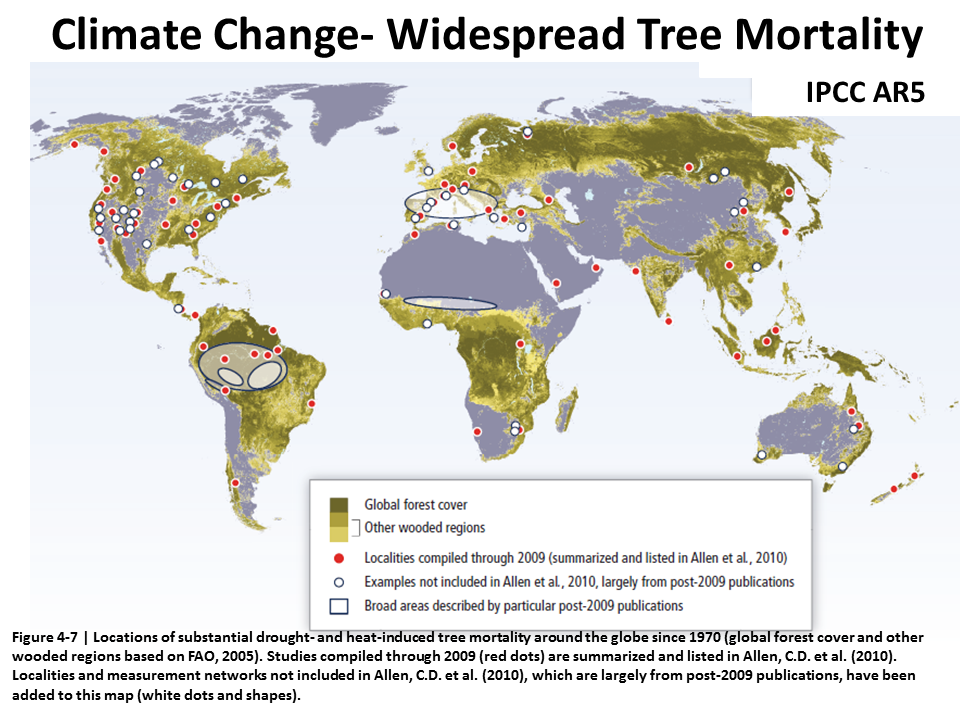
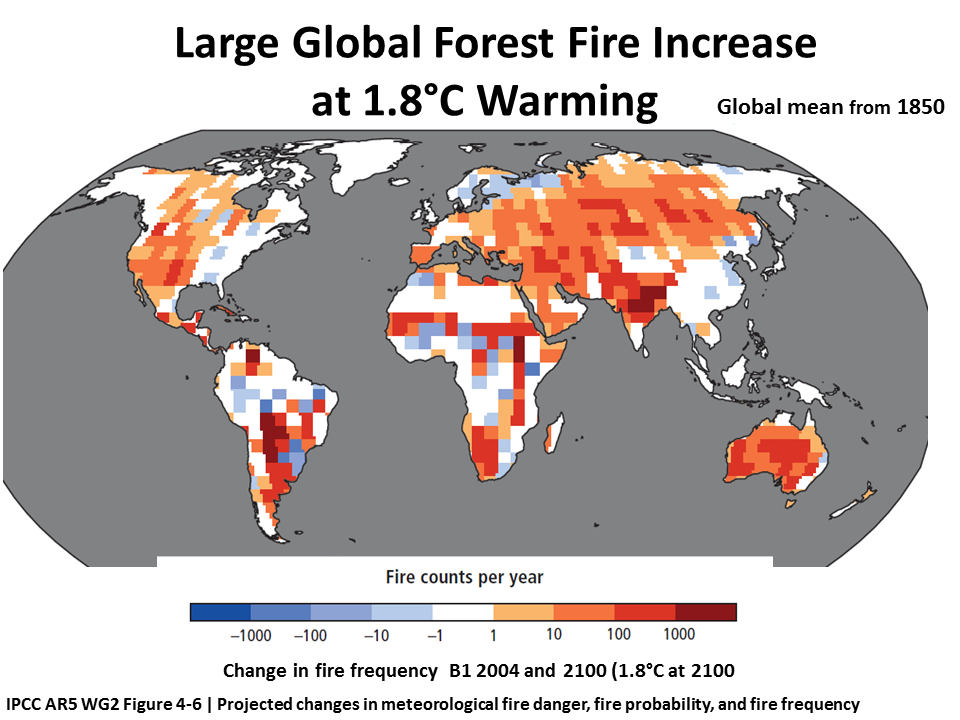
9 July 2015 bees
Article & VIDEO
Climate change killing off bumble bees
Article & VIDEO
Climate change killing off bumble bees

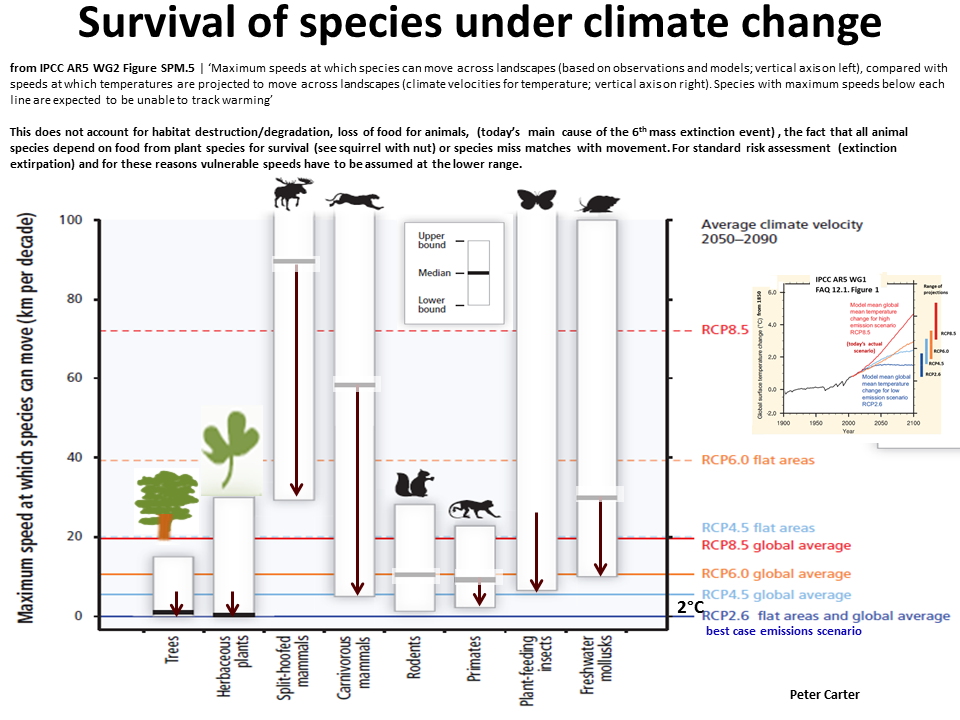

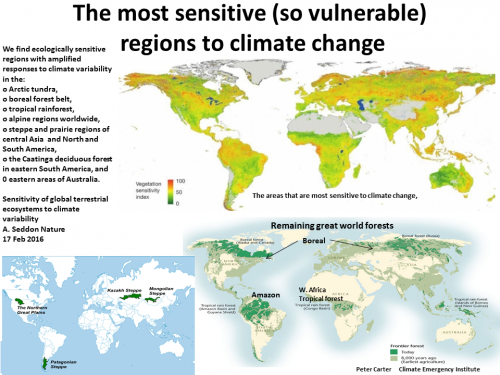

Latest research
Latest Research
By date
12 January 2021 Insects and recent climate change, C. A. Halsch, PNAS
12 Jan 2021 Insect decline in the Anthropocene: Death by a thousand cuts (Insect decline 1-2% year).
23 Dec 2021 Collision Course: Development Pushes Amazonia Toward Its Tipping Point (Collapse 2064)
23 Sept 2020 Amazon at tipping point for collapse (fire, climate change & deforestation)
18 Sept 2020 Change in Terrestrial Human Footprint Drives Continued Loss of Intact Ecosystems
Loss of 1.9m square kilometers (735,000 sq. miles) of intact ecosystems- an area the size of Mexico in just 13 years.
By date
12 January 2021 Insects and recent climate change, C. A. Halsch, PNAS
12 Jan 2021 Insect decline in the Anthropocene: Death by a thousand cuts (Insect decline 1-2% year).
23 Dec 2021 Collision Course: Development Pushes Amazonia Toward Its Tipping Point (Collapse 2064)
23 Sept 2020 Amazon at tipping point for collapse (fire, climate change & deforestation)
18 Sept 2020 Change in Terrestrial Human Footprint Drives Continued Loss of Intact Ecosystems
Loss of 1.9m square kilometers (735,000 sq. miles) of intact ecosystems- an area the size of Mexico in just 13 years.
Sept 2020 WWF Living Planet Report -68% from 1970
12 Aug 2020 Soil carbon loss by experimental warming in a tropical forest. Artificial warming High CO2 emissions
3 Aug 2020 Deforestation Physicists: 90% Chance of Human Society Collapsing Within Decades
20 July 2020 North Atlantic Right Whales Just One Step Away From Extinction
20 July 2020 Global warming shrinks bird breeding windows, potentially threatening species
9 July 2020 IUCN More than one in four of plant and animal species assessed at risk of extinction.
2 June 2020 Australia’s Great Barrier Reef suffered its most extensive coral bleaching event in March 2020, 3rd in 5 years, will not survive
12 Aug 2020 Soil carbon loss by experimental warming in a tropical forest. Artificial warming High CO2 emissions
3 Aug 2020 Deforestation Physicists: 90% Chance of Human Society Collapsing Within Decades
20 July 2020 North Atlantic Right Whales Just One Step Away From Extinction
20 July 2020 Global warming shrinks bird breeding windows, potentially threatening species
9 July 2020 IUCN More than one in four of plant and animal species assessed at risk of extinction.
2 June 2020 Australia’s Great Barrier Reef suffered its most extensive coral bleaching event in March 2020, 3rd in 5 years, will not survive
29 June 2020 End Permian worst extinction: Volcanic CO2-burning coal Paper
16 June 2020 Extinction accelerating fast- Vertebrates on the brink -indicators of biological annihilation and the sixth mass extinction
16 June 2020 Extinction accelerating fast- Vertebrates on the brink -indicators of biological annihilation and the sixth mass extinction
29 May 2020 Pervasive shifts in forest dynamics in a changing world
11 April 2020 Published Nature The fate of carbon in a mature forest under carbon dioxide enrichment. Forests do take up more carbon but do not sequester it.
8 April 2020
Swift global action to reduce greenhouse gas emissions could prevent the “abrupt” collapse of ecosystems,
22 March 2020 Vertebrates on the brink as indicators of biological annihilation and the sixth mass extinction ACCELERATING EXTINCTION
22 March 2020 Vertebrates on the brink as indicators of biological annihilation and the sixth mass extinction ACCELERATING EXTINCTION
7 Feb 2020 Climate change contributes to widespread declines among bumble bees across continents
13 Dec 2019 Pervasive human-driven decline of life on Earth points to the need for (immediate) transformative change
7 Nov 2019 Emperor penguins extinction
30 Oct 2019 Degradation and forgone removals increase the carbon impact of intact forest loss by 626%
Oct 30 2019 Royal Society NAP Climate & ecosystems
October 2019 Global Wetlands Outlook 35% global wetland loss since 1970 Wetlands store carbon
October 2019 Global Wetlands Outlook 35% global wetland loss since 1970 Wetlands store carbon
Oct 2019 Policy brief, Amazon could be just 2-3 yrs from tipping point
18 Oct 2019 Understanding extinction-humanity has destroyed half the life on Earth
11 Oct 2019 Global modelling of Natures contribution to people Up to 5 billion people at risk land and climate change
10 Oct 2019 54% of Washington birds at risk of extinction due to climate change, study says
22 Sept 2019 US bird numbers drop by nearly 3bn in 48 years US&Canada
22 Sept 2019 US bird numbers drop by nearly 3bn in 48 years US&Canada
20 Jun 2019
Climate change threatening the microscopic creatures our lives depend on
A deadly cascade: Extinctions trigger co-extinctions and further loss of biodiversity climate change
Paper 15 May 2019 Mutualistic interactions reshuffle the effects of climate change on plants across the tree of life
4 May 2019 Nature’s Dangerous Decline ‘Unprecedented IPBES’
25 April 2019 The world lost 12 million hectares (30 million acres) of tropical tree cover last year, the equivalent of 30 soccer pitches a minute
4 May 2019 Nature’s Dangerous Decline ‘Unprecedented IPBES’
25 April 2019 The world lost 12 million hectares (30 million acres) of tropical tree cover last year, the equivalent of 30 soccer pitches a minute
24 April 2019 United Nations report: One million species at risk of extinction: habitat loss, hunting, climate change, pollution, and alien species.
26 Mar 2019
Widespread losses of pollinating insects in Britain
5 Mar 2019 Bird extinctions 'driven' by global food trade Paper
3 March 2019 Alien species are primary cause of recent global extinctions
1 March 2019 Impacts of historical warming on marine fisheries production
6 Feb 2019 Underwater forests threatened by future climate change, new study finds
1 March 2019 Impacts of historical warming on marine fisheries production
6 Feb 2019 Underwater forests threatened by future climate change, new study finds
20 Jan 2019, Insect collapse Worldwide decline of the entomofauna (insects) PDF of paper
13 Nov 2018 Co-extinctions annihilate planetary life during extreme environmental change
November 13, 2018 Climate change damaging insect male fertility. paper
13 Nov 2018 Co-extinctions annihilate planetary life during extreme environmental change
30 Oct 2018 Climate-driven declines in arthropod abundance restructure a rainforest food web
VIDEO Oct 2018 Insects vanish all over world
Oct 2018 How Fossil Fuels and Climate Change Are Altering the Global Forest
15 Oct 2018 Climate-driven declines in arthropod abundance restructure a rainforest food web
23 July 2018Fish lose sense of smell and ability to find food as climate change turns oceans to acid
13 June 2018 Fifth of Britain’s wild mammals ‘at high risk of extinction’
27 June 2018 One football pitch (1.76 acres)of forest lost every second in 2017
39 million acres - global deforestation is on an upward trend,2nd worst year ever.
13 Nov 2018 Co-extinctions annihilate planetary life during extreme environmental change
November 13, 2018 Climate change damaging insect male fertility. paper
13 Nov 2018 Co-extinctions annihilate planetary life during extreme environmental change
30 Oct 2018 Climate-driven declines in arthropod abundance restructure a rainforest food web
VIDEO Oct 2018 Insects vanish all over world
Oct 2018 How Fossil Fuels and Climate Change Are Altering the Global Forest
15 Oct 2018 Climate-driven declines in arthropod abundance restructure a rainforest food web
23 July 2018Fish lose sense of smell and ability to find food as climate change turns oceans to acid
13 June 2018 Fifth of Britain’s wild mammals ‘at high risk of extinction’
27 June 2018 One football pitch (1.76 acres)of forest lost every second in 2017
39 million acres - global deforestation is on an upward trend,2nd worst year ever.
1 June 2018 Critical Decline of Earthworms
31 May 2018 Veg-vegan Biggest analysis to date reveals huge footprint of livestock
17 May 2018 R. Warren Limiting warming to 1.5 degree C would save majority of global species from climate change. See The Impact of Humanity on the Biosphere
May 14 2018 Netherlands Scientists concerned by dramatic decline in insect population
May 2018 Biomass of Earth
May 2018 State of World's Birds. One in eight bird species threatened with extinction.
18 May 2018 The projected effect on insects, vertebrates, and plants of limiting global warming to 1.5°C rather than 2°C. BIg benefit but still big loss
18 May 2018 Species threatened by climate change may not be able to relocate
March 2018 Biodiversity and Nature’s Contributions Continue Dangerous Decline, Scientists Warn.
Article Destruction of nature as dangerous as climate change, scientists warn
... threatens food and water security of billions of people, major UN-backed biodiversity study reveals
22 May 2018 Rapid warming is associated with population decline among
terrestrial birds and mammals globally
21 Mar 2018 Europe Where Have all the Farmland Birds Gone? Inquirer Catastrophe Pesticides eradicating insect food of birds.
14 Mar 2018 The implications of the United Nations Paris Agreement on climate change for globally significant biodiversity areas
3.2C could lead to the loss of almost 50% of animal species in the Amazon.
Around 60% of all species Madagascar – and up to 80% of mammals out in the Miombo Woodlands in southern Africa.
6 Mar 2018 Current deforestation pace will intensify global warming, study alerts
9 March 2018 Increasing tropical tree mortality in a warming world
26 Feb 2018 Study shows climate value of earth's intact forests. Conservation efforts and the fight against climate change risk failure unless intact forests are preserved
Feb 2018 Insects
Vanishing of the common species: Empty habitats and the role of genetic diversity
Feb 2018 Forests The exceptional value of intact forest ecosystems
Jan 2018 MME Saigas on the brink: Multidisciplinary analysis of the factors influencing mass mortality events
18 Oct 2017 More than 75 percent decline over 27 years in total flying insect biomass in protected areas
31 May 2018 Veg-vegan Biggest analysis to date reveals huge footprint of livestock
17 May 2018 R. Warren Limiting warming to 1.5 degree C would save majority of global species from climate change. See The Impact of Humanity on the Biosphere
May 14 2018 Netherlands Scientists concerned by dramatic decline in insect population
May 2018 Biomass of Earth
May 2018 State of World's Birds. One in eight bird species threatened with extinction.
18 May 2018 The projected effect on insects, vertebrates, and plants of limiting global warming to 1.5°C rather than 2°C. BIg benefit but still big loss
18 May 2018 Species threatened by climate change may not be able to relocate
March 2018 Biodiversity and Nature’s Contributions Continue Dangerous Decline, Scientists Warn.
Article Destruction of nature as dangerous as climate change, scientists warn
... threatens food and water security of billions of people, major UN-backed biodiversity study reveals
22 May 2018 Rapid warming is associated with population decline among
terrestrial birds and mammals globally
21 Mar 2018 Europe Where Have all the Farmland Birds Gone? Inquirer Catastrophe Pesticides eradicating insect food of birds.
14 Mar 2018 The implications of the United Nations Paris Agreement on climate change for globally significant biodiversity areas
3.2C could lead to the loss of almost 50% of animal species in the Amazon.
Around 60% of all species Madagascar – and up to 80% of mammals out in the Miombo Woodlands in southern Africa.
6 Mar 2018 Current deforestation pace will intensify global warming, study alerts
9 March 2018 Increasing tropical tree mortality in a warming world
26 Feb 2018 Study shows climate value of earth's intact forests. Conservation efforts and the fight against climate change risk failure unless intact forests are preserved
Feb 2018 Insects
Vanishing of the common species: Empty habitats and the role of genetic diversity
Feb 2018 Forests The exceptional value of intact forest ecosystems
Jan 2018 MME Saigas on the brink: Multidisciplinary analysis of the factors influencing mass mortality events
18 Oct 2017 More than 75 percent decline over 27 years in total flying insect biomass in protected areas
13 Oct 2017 Tropical forests are a net carbon source based on aboveground measurements of gain and loss
Sept 2017 (glyphosate) Monarch butterfly population decline in North America: identifying the threatening processes
Sept 2017 Parasite biodiversity faces extinction and redistribution in a changing climate
May 2017 Trends in size of tropical deforestation events signal increasing dominance of industrial-scale drivers
13 Sept 2017 Science Daily (See maps)Climate change challenges the survival of fish across the world first analysis looking at how vulnerable the world's freshwater and marine fishes are to climate change.
May 2017 Biological annihilation via the ongoing sixth mass extinction signaled by vertebrate population
losses and declines
Oct 2017 Germany’s insects are disappearing: surrounding agricultural intensification
Oct 2017 Over twelve million bird breeding pairs less in Germany
4 Oct 2017 Expert warns of 'huge decline' in Canada's bug population
17 Aug 2017 The impact of tree age on biomass growth and carbon accumulation capacity KEEP the TREES
May 2017 Insects Where have all the insects gone
10 April 2017 Flammable (central) floodplains are weak spot of Amazon forest
April 2017 Tree mortality across biomes is promoted by drought intensity,
March 15 2017 U Texas
Recovery after “Great Dying” Was Slowed by More Extinctions- all casued by volcanism CO2.
March 2017 Paper Subsequent biotic crises ...Permian mass extinction
Feb 2017 IUCN Invasive alien species on the rise worldwide
2017 Kew 1St State of the Worlds Plants
Feb 2017 Greenhouse gas emissions from tropical forest degradation: an underestimated source
4 Jan 2017 Domino effect: The loss of plant species triggers the extinction of animals
The simulation indicates that the initial spark for extinction cascades as a result of climate change mostly originates from plant species-transferred to animal species.
8 Dec 2016 Climate-Related Local Extinctions Are Already
Widespread among Plant and Animal Species
Sept 2017 (glyphosate) Monarch butterfly population decline in North America: identifying the threatening processes
Sept 2017 Parasite biodiversity faces extinction and redistribution in a changing climate
May 2017 Trends in size of tropical deforestation events signal increasing dominance of industrial-scale drivers
13 Sept 2017 Science Daily (See maps)Climate change challenges the survival of fish across the world first analysis looking at how vulnerable the world's freshwater and marine fishes are to climate change.
May 2017 Biological annihilation via the ongoing sixth mass extinction signaled by vertebrate population
losses and declines
Oct 2017 Germany’s insects are disappearing: surrounding agricultural intensification
Oct 2017 Over twelve million bird breeding pairs less in Germany
4 Oct 2017 Expert warns of 'huge decline' in Canada's bug population
17 Aug 2017 The impact of tree age on biomass growth and carbon accumulation capacity KEEP the TREES
May 2017 Insects Where have all the insects gone
10 April 2017 Flammable (central) floodplains are weak spot of Amazon forest
April 2017 Tree mortality across biomes is promoted by drought intensity,
March 15 2017 U Texas
Recovery after “Great Dying” Was Slowed by More Extinctions- all casued by volcanism CO2.
March 2017 Paper Subsequent biotic crises ...Permian mass extinction
Feb 2017 IUCN Invasive alien species on the rise worldwide
2017 Kew 1St State of the Worlds Plants
Feb 2017 Greenhouse gas emissions from tropical forest degradation: an underestimated source
4 Jan 2017 Domino effect: The loss of plant species triggers the extinction of animals
The simulation indicates that the initial spark for extinction cascades as a result of climate change mostly originates from plant species-transferred to animal species.
8 Dec 2016 Climate-Related Local Extinctions Are Already
Widespread among Plant and Animal Species
June 2015 Climate change, ecocide and crimes of the powerful Rob White
1 May 2015, Accelerating extinction risk from climate change
Mark C. Urban*
2015 The Anthropocene is distinct from the Holocene, Colin Waters.
1 May 2015, Accelerating extinction risk from climate change
Mark C. Urban*
2015 The Anthropocene is distinct from the Holocene, Colin Waters.
8 Dec 2016 Climate-Related pant & animal local extinctions already Widespread
10 Nov 2016Climate change already dramatically disrupting all elements of nature.
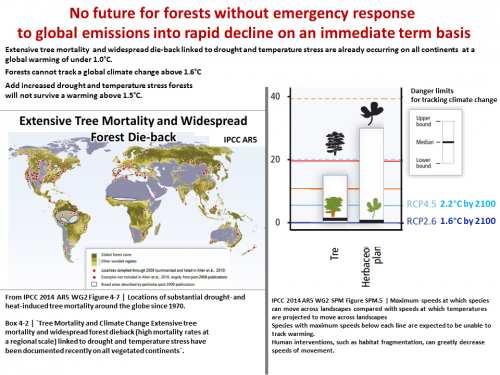
A Glikson 2013 Past extinctions - climate
May 2017 'Biological Annihilation' Rapidly increasing rate of species extinctions EARTH EMEGENCY
Insects
SaveNature Importance of insects
What Would Happen If All Earth’s Insects Vanished?
Science Explorer 2015 If insects were to disappear, the world would fall apart — there's no two ways about it,"
SaveNature Importance of insects
What Would Happen If All Earth’s Insects Vanished?
Science Explorer 2015 If insects were to disappear, the world would fall apart — there's no two ways about it,"
Call of Life (project)
Facing Mass Exinction
Call of Life film on Youtube
Facing Mass Exinction
Call of Life film on Youtube
Double Feedback Global climate change will boost today's
already 6th Earth mass extinction event and cause
damage to ecosystems which will increase global climate change
by reduction of CO2 uptake.
'Extensive tree mortality and widespread forest dieback (high mortality at regional scale) linked to drought and temperature stress have been documented recently on all vegetated continents' (IPCC 2014 WG2 Box 4.2)
23 March 2018 Huge assessment Destruction of nature ... threatens food and water security of billions of people, major UN-backed biodiversity study reveals IPBES report
already 6th Earth mass extinction event and cause
damage to ecosystems which will increase global climate change
by reduction of CO2 uptake.
'Extensive tree mortality and widespread forest dieback (high mortality at regional scale) linked to drought and temperature stress have been documented recently on all vegetated continents' (IPCC 2014 WG2 Box 4.2)
23 March 2018 Huge assessment Destruction of nature ... threatens food and water security of billions of people, major UN-backed biodiversity study reveals IPBES report
Comprehensive Information 6th Mass Extinction
SENCKENBERG Bidiversity & Climate Research Center
2015 The Trajectory of the Anthropocene Great Acceleration
2008 New Scientist How Our Economy is Killing the Earth
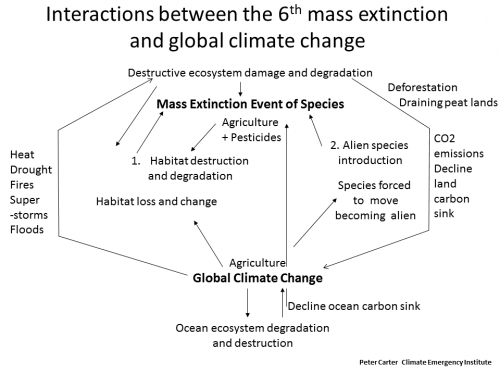
Feb 2017 One fifth of worlds plants threatened with extinction
Kew State of World's Plants Short Article
Kew State of World's Plants Short Article
FAO 2018 State of World's Forests Deforestation "nearly 20% CO2 emissions"

May warming associated with population decline of terrestrial birds & mammals globally
VIDEO Oct 2018 Insects vanish all over world
2017 Lima Declaration
Biodiversity & Climate Change
Biodiversity & Climate Change
2019 Biodiversity & climate change My book chapter
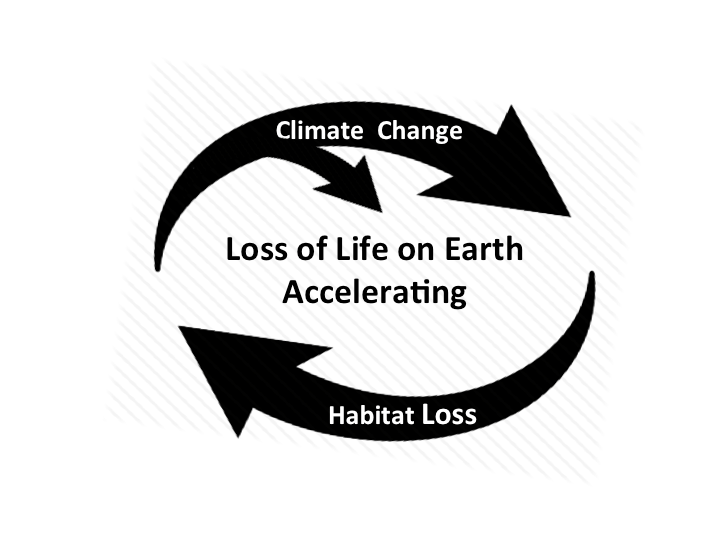
Eradicating Ecocide site

May 2015 Global climate change will further accelerate extinctions. Accelerating extinction risk from climate change,
Mark C. Urban
Mark C. Urban

FILM Sea of Life
15 May 2019 Deadly Cascade
August 2019 WWF calls Planetary Emergency
13 Dec 2019 Pervasive human-driven decline of life on Earth needs (immediate) transformative change
Sept 2020 WWF Unprecedented wildlife decline -68% since 1970
Sept 2020 WWF Unprecedented wildlife decline -68% since 1970
1996 Richard Leakey The Sixth Extinction: Patterns of Life & the Future of Humankind